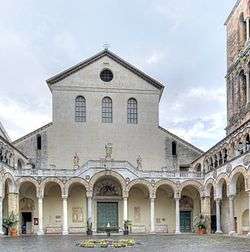Roman Catholic Archdiocese of Salerno-Campagna-Acerno
| Archdiocese of Salerno-Campagna-Acerno Archidioecesis Salernitanus-Campaniensis-Acernensis | |
|---|---|
 Salerno Cathedral | |
| Location | |
| Country | Italy |
| Ecclesiastical province | Salerno-Campagna-Acerno |
| Statistics | |
| Area | 1,398 km2 (540 sq mi) |
| Population - Total - Catholics |
(as of 2010) 552,000 540,000 (97.8%) |
| Parishes | 163 |
| Information | |
| Denomination | Catholic Church |
| Rite | Roman Rite |
| Established | 6th century |
| Cathedral | Cattedrale-Basilica di S. Matteo (Salerno) |
| Co-cathedral |
Concattedrale-Basilica di S. Maria della Pace (Campagna) Concattedrale di S. Donato (Acerno) |
| Current leadership | |
| Pope | Francis |
| Archbishop | Luigi Moretti |
| Emeritus Bishops | Gerardo Pierro |
| Website | |
| www.diocesisalerno.it | |
The Archdiocese of Salerno-Campagna-Acerno (Latin: Archidioecesis Salernitanus-Campaniensis-Acernensis) is a Roman Catholic ecclesiastical territory in Campania, southern Italy, created in 1986. The historic Archdiocese of Salerno was in existence from the tenth century, having been elevated from a sixth-century diocese. The Diocese of Acerno was combined with the archdiocese in 1818.[1]
On Thursday, June 10, 2010, Pope Benedict XVI appointed Archbishop Luigi Moretti, until then the vice-gerent of the Vicariate of Rome, as Archbishop, succeeding Archbishop Gerardo Pierro.
History
Gaudentius was bishop in 499. Other bishops were: Asterius, who went to Constantinople with Pope Agapitus in 534; St Gaudiosus (eighth century); Petrus (834), formerly Bishop of Canusio, who took refuge at Salerno when the Saracens destroyed his capital, and built the Church of San Giovanni Battista; Bernardus (850), who restored several buildings.
In the eighth century the city of Salerno was in the power of the Lombard dukes of Benevento. In 984 Salerno became an archiepiscopal see, the first archbishop being Amato. Other archbishops were:
- San Alfano (1058–85), who received the exiled Pope Gregory VII
- Romualdo I (1121)
- Romualdo II Guarna (1153)
- Nicolo Agello (1181)
- Caesarius of Alagno (1225–63)
- Guglielmo de' Godoni (1298), chancellor of the Duke of Calabria, whose successors, to Orso Minutolo (1330), resided at Avignon
- Barnaba Orsini (1441), who restored the cathedral
- Pietro Guglielmo Rocca (d. 1482)
- Giovanni Vera (1500), later a cardinal, who was sent on several pontifical legations to France and to England
- Girolamo Seripando (1554), theologian and former general of the Augustinians, whose doctrines on justification, akin to those of Luther, were rejected at the Council of Trent, and who afterwards became a cardinal
- Gaspar Cervantes de Gaeta (1564), who founded the seminary
- Marc Antonio Colonna (1568), who established another college for clerics
- his nephew, Marc Antonio Colonna (1574), the author
- Mario Bolognini (1591), who distinguished himself in France in the controversies with the Huguenots;
- Giovanni de Torres (1658), who reformed the lives of the clergy;
- Gregorio Caraffa (1664), a Theatine and reformer;
- Antonio Salomone, who, after the annexation of the kingdom of Naples, was imprisoned without reason (1886), and at the beginning of the war with Austria was sent into exile.
From 1818 Salerno had for suffragans the diocese of Capaccio e Vallo, diocese of Policastro, diocese of Potenza e Marsico Nuovo, and diocese of Nusco.
The See of Acerno, which appears a diocese since 1136, is united with it; among its bishops was the Franciscan Antonio Bonito (1493).
See also
References
- Cappelletti, Le Chiese d'Italia, XX (Venice, 1857);
Notes
External links
![]() This article incorporates text from a publication now in the public domain: Herbermann, Charles, ed. (1913). Catholic Encyclopedia. New York: Robert Appleton.
This article incorporates text from a publication now in the public domain: Herbermann, Charles, ed. (1913). Catholic Encyclopedia. New York: Robert Appleton.
| ||||||
Coordinates: 40°41′00″N 14°46′00″E / 40.6833°N 14.7667°E
